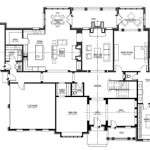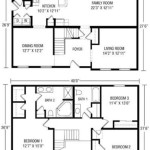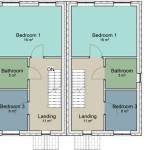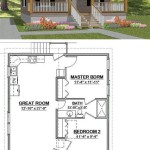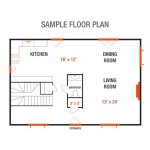Octagon House Plans are architectural designs for houses featuring eight sides. These plans offer unique geometrical configurations, providing ample space, natural light, and distinctive aesthetics. An example of an Octagon House is the Orson Squire Fowler House in New York, built in the mid-19th century, showcasing the octagonal design’s functionality and beauty.
Octagon House Plans have gained popularity due to their numerous advantages. These plans provide efficient use of space, allowing for expansive rooms and open floor plans. The multiple sides offer ample natural light, reducing energy consumption and creating a brighter and more inviting atmosphere. Furthermore, the octagonal shape provides exceptional structural stability, making these houses more resistant to harsh weather conditions.
In the following sections, we will delve into the details of Octagon House Plans, exploring their benefits, design considerations, and construction techniques. We will also provide examples of notable Octagon Houses and discuss the historical significance of this architectural style.
Octagon House Plans offer unique advantages and considerations. Here are 10 important points to note:
- Distinctive and striking design
- Efficient use of space
- Ample natural light
- Exceptional structural stability
- Improved air circulation
- Energy efficiency
- Historical significance
- Versatile floor plans
- Customizable designs
- Increased property value
These factors make Octagon House Plans an attractive option for homeowners seeking unique, functional, and sustainable homes.
Distinctive and striking design
Octagon House Plans stand out for their distinctive and striking design. The eight sides create a unique geometric shape that is both visually appealing and practical. The symmetrical layout provides a harmonious and balanced appearance, while the multiple angles and facets add depth and interest to the exterior. Octagon Houses are often characterized by large windows and balconies, which take advantage of the natural light and offer panoramic views of the surrounding landscape.
The octagonal shape also allows for a more efficient use of space, as it eliminates wasted corners and creates more usable floor area. This makes Octagon Houses ideal for homeowners who want to maximize space without sacrificing style or comfort. Additionally, the multiple sides provide ample natural light, reducing the need for artificial lighting and creating a brighter and more inviting atmosphere.
Another unique feature of Octagon House Plans is their exceptional structural stability. The octagonal shape distributes weight evenly, making these houses more resistant to high winds, earthquakes, and other natural disasters. This makes them a great choice for areas prone to severe weather conditions.
Overall, the distinctive and striking design of Octagon House Plans offers a combination of aesthetic appeal, functionality, and durability. These houses are sure to turn heads and make a statement in any neighborhood.
Efficient use of space
Octagon House Plans offer an efficient use of space due to their unique geometric shape. The eight sides eliminate wasted corners and create more usable floor area compared to traditional rectangular or square houses. This makes Octagon Houses ideal for homeowners who want to maximize space without sacrificing style or comfort.
The symmetrical layout of Octagon House Plans also contributes to their space efficiency. The central core of the house often contains the main living areas, such as the living room, dining room, and kitchen. This central core is surrounded by the bedrooms and other private spaces, which are accessed through hallways or corridors. This layout minimizes wasted space and allows for a more efficient flow of traffic throughout the house.
Another space-saving feature of Octagon House Plans is their ability to incorporate multi-purpose rooms. The octagonal shape allows for rooms that can serve multiple functions, such as a guest room that can also be used as a home office or a playroom that can also be used as a study area. This flexibility reduces the need for additional rooms and helps to maximize the use of available space.
Overall, Octagon House Plans offer an efficient use of space through their unique geometric shape, symmetrical layout, and multi-purpose rooms. These features make Octagon Houses ideal for homeowners who want to maximize space without compromising on style or functionality.
Ample natural light
Octagon House Plans are designed to take advantage of natural light, creating brighter and more inviting living spaces.
- Multiple windows and balconies
Octagon Houses feature numerous windows and balconies, which allow for an abundance of natural light to enter the home. The multiple sides of the house provide ample opportunities for windows and doors, ensuring that every room is well-lit.
- Large windows
The windows in Octagon Houses are often large and strategically placed to maximize natural light. Large windows in the living areas, such as the living room and dining room, provide panoramic views of the surrounding landscape and flood the space with natural light.
- Clerestory windows
Clerestory windows are often incorporated into Octagon House Plans. These windows are located high on the walls near the ceiling, allowing natural light to enter the upper levels of the house. Clerestory windows provide additional light without compromising privacy.
- Light-colored interiors
Octagon Houses often feature light-colored interiors, which help to reflect and distribute natural light throughout the home. Light-colored walls, ceilings, and flooring create a brighter and more spacious atmosphere.
The ample natural light in Octagon House Plans not only reduces the need for artificial lighting, but also creates a healthier and more comfortable living environment. Natural light has been shown to improve mood, boost productivity, and reduce stress levels.
Exceptional structural stability
Octagon House Plans are renowned for their exceptional structural stability. The unique octagonal shape, combined with specific design features, contributes to the durability and resilience of these houses.
- Even weight distribution
The octagonal shape of Octagon House Plans distributes weight evenly throughout the structure. This is in contrast to traditional rectangular houses, where the weight is concentrated on the corners. The even weight distribution in Octagon Houses reduces stress on the walls and foundation, making them more resistant to cracking and other structural damage.
- Triangulation
The walls of Octagon Houses often incorporate triangulation, which is a structural technique that uses triangles to reinforce the structure. Triangulation creates a strong and stable framework that resists lateral forces, such as high winds and earthquakes. The multiple angles and facets of the octagonal shape allow for numerous triangulation opportunities, enhancing the overall structural stability of the house.
- Central core
Many Octagon House Plans feature a central core that serves as the structural backbone of the house. The central core typically contains the main living areas, such as the living room, dining room, and kitchen. This central core provides additional support to the surrounding walls and helps to stabilize the entire structure.
- Wind resistance
The octagonal shape of Octagon House Plans also contributes to their wind resistance. The multiple sides of the house break up the force of the wind, reducing the risk of wind damage. Additionally, the symmetrical layout of Octagon Houses helps to distribute the wind load evenly throughout the structure, further enhancing its wind resistance.
The exceptional structural stability of Octagon House Plans makes them ideal for areas prone to severe weather conditions, such as hurricanes, earthquakes, and high winds. These houses are built to withstand the elements and provide a safe and secure living environment for their occupants.
Improved air circulation
Octagon House Plans offer improved air circulation due to their unique shape and design features.
The multiple sides of an Octagon House create numerous opportunities for windows and doors. This allows for cross-ventilation, which is the movement of air through a space from multiple directions. Cross-ventilation helps to circulate fresh air throughout the house, removing stale air and reducing the buildup of pollutants and moisture.
In addition to cross-ventilation, the octagonal shape of these houses promotes natural convection currents. Convection currents are caused by the rising of warm air and the sinking of cool air. In an Octagon House, the warm air rises to the central core of the house, which often features a high ceiling or cupola. The cool air then sinks down the exterior walls and is replaced by fresh air entering through the windows and doors. This natural convection helps to circulate air throughout the house and maintain a comfortable temperature.
Furthermore, Octagon House Plans often incorporate design features that enhance air circulation. For example, many Octagon Houses have open floor plans, which allow air to flow freely between different rooms. Additionally, some Octagon Houses feature clerestory windows, which are high windows near the ceiling that allow warm air to escape and fresh air to enter.
The improved air circulation in Octagon House Plans provides several benefits. It helps to reduce the risk of indoor air pollution and moisture problems, which can lead to health issues. Additionally, good air circulation helps to regulate temperature and humidity levels, creating a more comfortable and healthy living environment.
Energy efficiency
Octagon House Plans offer several features that contribute to their energy efficiency.
The octagonal shape of these houses helps to reduce heat loss and gain. The multiple sides of the house create a smaller surface area relative to the volume of the house. This means that there is less exterior wall area through which heat can escape or enter. Additionally, the symmetrical layout of Octagon Houses helps to distribute heat evenly throughout the house, reducing the need for additional heating or cooling.
Octagon House Plans often incorporate passive solar design principles. Passive solar design takes advantage of the sun’s energy to heat and cool a building naturally. In Octagon Houses, large windows are typically placed on the south side of the house to capture the sun’s heat during the winter months. Overhangs or awnings can be used to shade the windows during the summer months, preventing the house from overheating.
Many Octagon House Plans also feature energy-efficient building materials and systems. These materials and systems can include insulated walls and ceilings, high-performance windows, and energy-efficient appliances. By incorporating these features, Octagon Houses can significantly reduce their energy consumption and utility bills.
Overall, the energy efficiency of Octagon House Plans is a major advantage for homeowners who are looking to reduce their environmental impact and save money on energy costs.
Historical significance
Octagon House Plans have a rich historical significance and have been associated with various architectural movements and social trends throughout history.
- Orson Squire Fowler and the Octagon Movement
Orson Squire Fowler, a prominent American phrenologist and architectural writer, is credited with popularizing Octagon House Plans in the mid-19th century. Fowler believed that the octagonal shape was ideal for promoting health and well-being. He published several books and articles advocating for the octagon house design, and his ideas gained a following among architects and homeowners alike. Many Octagon Houses were built during this period, particularly in the United States.
- Usonian architecture
In the early 20th century, Octagon House Plans were embraced by Frank Lloyd Wright, one of the most influential architects of all time. Wright incorporated the octagonal shape into his Usonian architecture, which emphasized simplicity, functionality, and affordability. Wright designed several Octagon Houses, including the Jacobs House in Wisconsin and the Rosenbaum House in Alabama. These houses showcased Wright’s innovative use of the octagonal shape and his commitment to creating organic and harmonious living spaces.
- Alternative and sustainable living
In recent years, Octagon House Plans have experienced a resurgence in popularity due to their association with alternative and sustainable living. The octagonal shape is seen as a symbol of balance and harmony, and Octagon Houses are often designed with eco-friendly features, such as solar panels, rainwater harvesting systems, and natural building materials. These houses appeal to homeowners who are looking for unique and sustainable ways to live.
- Architectural heritage
Many Octagon Houses built in the 19th and early 20th centuries have been preserved and are now considered architectural landmarks. These houses showcase the unique design features of the Octagon House movement and Usonian architecture. They are often listed on historical registers and protected from demolition or alteration. Preserving these historic Octagon Houses helps to ensure that future generations can appreciate and learn from this important architectural style.
The historical significance of Octagon House Plans lies in their association with influential architectural movements, their embodiment of social and cultural values, and their enduring appeal as unique and sustainable homes.
Versatile floor plans
Octagon House Plans offer versatile floor plans that can be customized to meet the specific needs and preferences of homeowners. The unique octagonal shape allows for a variety of room configurations and layouts, providing flexibility and adaptability.
One of the key advantages of Octagon House Plans is their ability to accommodate both open and closed floor plans. Open floor plans feature large, interconnected spaces with minimal walls or partitions. This type of floor plan creates a sense of spaciousness and allows for easy flow of traffic and natural light. Closed floor plans, on the other hand, offer more traditional room layouts with separate rooms for different functions, such as bedrooms, bathrooms, and living areas. Octagon House Plans can be designed to incorporate both open and closed floor plan elements, providing homeowners with the best of both worlds.
Another advantage of Octagon House Plans is their flexibility in terms of room placement. The octagonal shape allows for a variety of room arrangements, including radial layouts, where rooms are arranged around a central core, and linear layouts, where rooms are arranged along a central axis. This flexibility gives homeowners the freedom to create floor plans that suit their individual lifestyles and preferences.
Furthermore, Octagon House Plans can be easily modified to accommodate changes in family size or lifestyle. The modular nature of the octagonal shape makes it possible to add or remove rooms as needed, without compromising the structural integrity of the house. This adaptability ensures that Octagon Houses can grow and change along with the needs of their occupants.
Overall, the versatility of Octagon House Plans allows homeowners to create unique and functional living spaces that meet their specific needs and preferences. The ability to customize the floor plan, accommodate both open and closed spaces, and modify the layout over time makes Octagon Houses a highly desirable option for homeowners seeking flexibility and adaptability in their homes.
Customizable designs
Octagon House Plans offer a high degree of customization, allowing homeowners to create unique and personalized living spaces that reflect their individual tastes and preferences. The octagonal shape provides a flexible framework that can be adapted to a wide range of design styles and functional requirements.
- Exterior finishes
Homeowners can choose from a variety of exterior finishes to customize the look of their Octagon House. Options include siding, stucco, brick, stone, and wood. The octagonal shape lends itself well to both traditional and contemporary exterior designs, allowing homeowners to create a house that complements their neighborhood and personal aesthetic.
- Roofing options
Octagon House Plans can accommodate a variety of roofing options, including asphalt shingles, metal roofing, and tile roofing. The unique shape of the house allows for creative and visually appealing roof designs, such as multi-gabled roofs and cupolas. Homeowners can choose a roofing material and design that complements the exterior finish and overall architectural style of their house.
- Interior layout
As mentioned earlier, Octagon House Plans offer versatile floor plans that can be customized to meet the specific needs and preferences of homeowners. The octagonal shape allows for a variety of room configurations and layouts, providing flexibility in the placement and size of rooms. Homeowners can work with an architect or designer to create an interior layout that maximizes space, natural light, and flow of traffic.
- Architectural details
Octagon House Plans can be further customized with a variety of architectural details, such as porches, balconies, decks, and bay windows. These details can enhance the functionality and aesthetic appeal of the house. Homeowners can choose from a range of architectural styles, from Victorian to modern, to incorporate into their Octagon House design.
The customizable designs of Octagon House Plans empower homeowners to create unique and personalized homes that meet their specific needs and preferences. The flexibility of the octagonal shape allows for a wide range of design options, ensuring that each Octagon House is a one-of-a-kind masterpiece.
Increased property value
Octagon House Plans can contribute to increased property value due to their unique design, historical significance, and desirability among buyers.
- Distinctive design
The unique and striking design of Octagon House Plans sets them apart from traditional rectangular or square houses. This distinctive design can increase curb appeal and make the property more visually appealing to potential buyers. A well-maintained and architecturally significant Octagon House can become a landmark in the neighborhood, attracting attention and admiration.
- Historical significance
As discussed earlier, Octagon House Plans have a rich historical significance, dating back to the mid-19th century. Many Octagon Houses are listed on historical registers and are considered architectural landmarks. Owning a historic Octagon House can add prestige and value to the property. Potential buyers who appreciate historical architecture and the preservation of cultural heritage may be willing to pay a premium for such a unique and significant home.
- Desirability and demand
Octagon House Plans are in high demand due to their unique design, historical significance, and the growing popularity of alternative and sustainable living. The limited supply of Octagon Houses, combined with the increasing demand, can drive up property values. Homeowners who own Octagon Houses may have an advantage in the real estate market, as potential buyers are often willing to pay a higher price for these unique and desirable properties.
- Investment potential
Investing in an Octagon House can be a wise financial decision. Due to their historical significance, architectural value, and increasing desirability, Octagon Houses tend to hold their value well over time and may even appreciate in value. Homeowners who purchase and maintain an Octagon House can potentially reap the benefits of a solid investment and enjoy the financial rewards of owning a unique and valuable property.
Overall, the increased property value associated with Octagon House Plans is a result of their distinctive design, historical significance, desirability among buyers, and investment potential. These factors make Octagon Houses highly sought-after properties that can provide homeowners with both financial and aesthetic benefits.










Related Posts

